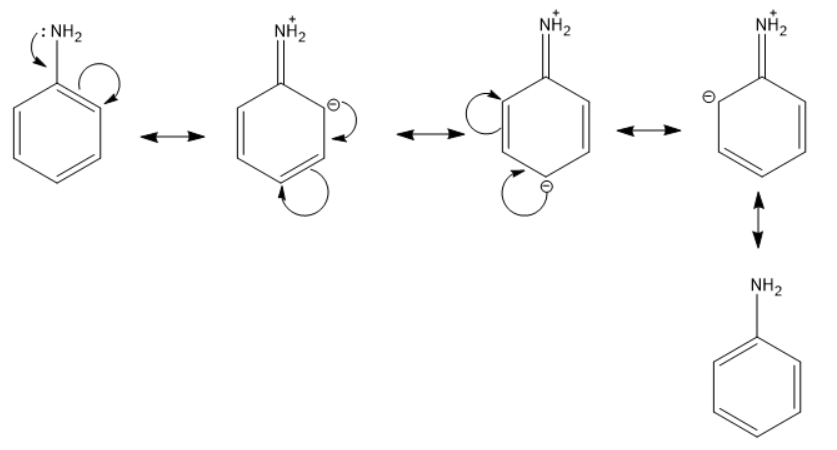
Which of the following has +R (resonance) effect?
a.) \[-CN\]
b.) \[-CHO\]
c.) \[-N{{H}_{2}}\]
d.) \[-N{{O}_{2}}\]
Answer
571.8k+ views
Hint: +R effect is the positive resonance effect and it is shown by electron donating groups. We can take help of canonical structures to see how there is a withdrawal or releasing effect of electrons attributed to a particular substituent through the delocalization of π or pi-electron.
Complete step by step answer:
The two types of resonance or mesomeric effects. They are-
+R or +M
-R or -M
Negative resonance or mesomeric effect (-M or -R): It is shown by the groups that withdraw electrons by delocalization mechanism from the rest of the conjugated molecule and are denoted by -M or -R. The electron density on the rest of the molecular entity is decreased due to this effect.
Examples of groups showing negative resonance are \[N{{O}_{2}}\], CO, COOH, CN, CHO etc.
Positive resonance or mesomeric effect (+M or +R): It is shown by the groups that donates or releases electrons to the rest of the conjugated molecule by delocalization. These groups are denoted by +M or +R. Due to this effect, the electron density on the rest of the molecular entity is increased.
Examples of groups showing positive resonance are \[N{{H}_{2}}\], OR, SH, OH etc.
Now, let us see the options given and check if they are electron donating or withdrawing.
At first we have –CN. Cyanide group has a positive group i.e. C directly attached to the benzene ring. Therefore, it will show –R resonance effect.
Then we have –CHO. Here also we have a positive group carbon directly attached to the benzene ring and it will pull electrons towards it. Thus, it will show –R effect.
Next we have \[-N{{H}_{2}}\] . Here, the negative group is attached to the benzene ring and thus will donate its electron cloud resulting in +R effect.
The mechanism can be given as below.

And lastly we have $-N{{O}_{2}}$. If we compare nitrogen and oxygen, nitrogen is more electropositive therefore it will show –R effect.
We can understand from the above discussion that $-N{{H}_{2}}$ will show +R.
So, the correct answer is “Option C”.
Note: There is polarity produced in a molecule by the interaction between a lone electron pair and a pi bond. It is generally found in molecules with conjugated double bonds or in molecules having at least one lone pair and one double bond.
A carbocation is stabilised through +R effect i.e. resonance of the positive charge around the ring. But there are some cases where an alkyl carbocation with a +I effect is more stable than a carbocation with +R group although resonance effect has higher priority.
Complete step by step answer:
The two types of resonance or mesomeric effects. They are-
+R or +M
-R or -M
Negative resonance or mesomeric effect (-M or -R): It is shown by the groups that withdraw electrons by delocalization mechanism from the rest of the conjugated molecule and are denoted by -M or -R. The electron density on the rest of the molecular entity is decreased due to this effect.
Examples of groups showing negative resonance are \[N{{O}_{2}}\], CO, COOH, CN, CHO etc.
Positive resonance or mesomeric effect (+M or +R): It is shown by the groups that donates or releases electrons to the rest of the conjugated molecule by delocalization. These groups are denoted by +M or +R. Due to this effect, the electron density on the rest of the molecular entity is increased.
Examples of groups showing positive resonance are \[N{{H}_{2}}\], OR, SH, OH etc.
Now, let us see the options given and check if they are electron donating or withdrawing.
At first we have –CN. Cyanide group has a positive group i.e. C directly attached to the benzene ring. Therefore, it will show –R resonance effect.
Then we have –CHO. Here also we have a positive group carbon directly attached to the benzene ring and it will pull electrons towards it. Thus, it will show –R effect.
Next we have \[-N{{H}_{2}}\] . Here, the negative group is attached to the benzene ring and thus will donate its electron cloud resulting in +R effect.
The mechanism can be given as below.

And lastly we have $-N{{O}_{2}}$. If we compare nitrogen and oxygen, nitrogen is more electropositive therefore it will show –R effect.
We can understand from the above discussion that $-N{{H}_{2}}$ will show +R.
So, the correct answer is “Option C”.
Note: There is polarity produced in a molecule by the interaction between a lone electron pair and a pi bond. It is generally found in molecules with conjugated double bonds or in molecules having at least one lone pair and one double bond.
A carbocation is stabilised through +R effect i.e. resonance of the positive charge around the ring. But there are some cases where an alkyl carbocation with a +I effect is more stable than a carbocation with +R group although resonance effect has higher priority.
Recently Updated Pages
Master Class 12 English: Engaging Questions & Answers for Success

Master Class 12 Business Studies: Engaging Questions & Answers for Success

Master Class 12 Economics: Engaging Questions & Answers for Success

Master Class 12 Social Science: Engaging Questions & Answers for Success

Master Class 12 Maths: Engaging Questions & Answers for Success

Master Class 12 Chemistry: Engaging Questions & Answers for Success

Trending doubts
What are the major means of transport Explain each class 12 social science CBSE

Which are the Top 10 Largest Countries of the World?

Draw a labelled sketch of the human eye class 12 physics CBSE

Explain sex determination in humans with line diag class 12 biology CBSE

The pH of the pancreatic juice is A 64 B 86 C 120 D class 12 biology CBSE

Explain sex determination in humans with the help of class 12 biology CBSE




